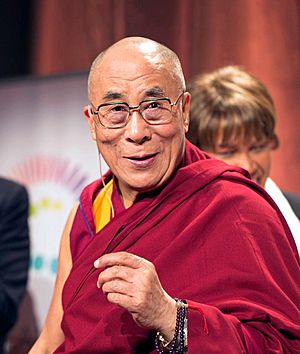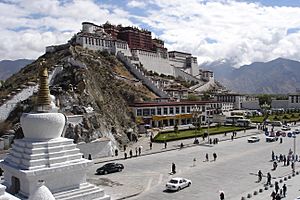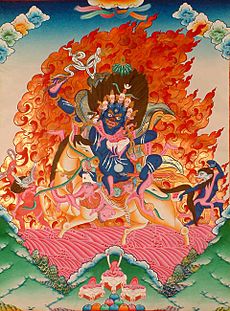Dalai Lama facts for kids
Quick facts for kids Dalai Lama |
|
|---|---|
| Residence | McLeod Ganj, Dharamshala, India |
| Formation | 1391 |
| First holder | Gendün Drubpa, 1st Dalai Lama |
The Dalai Lama is a very important spiritual leader for the Tibetan people. This special title is given to the main leader of the Gelug school of Tibetan Buddhism. This school is the newest and largest of the four main types of Tibetan Buddhism. The current Dalai Lama is Tenzin Gyatso, who is the 14th person to hold this title. He lives in India as a refugee.
Many Buddhists believe that the Dalai Lamas are special people. They are thought to be new forms, or "incarnations," of Avalokiteśvara. This is the Bodhisattva of Compassion, a being who helps others.
Since the 1600s, the 5th Dalai Lama became a symbol of unity for Tibet. He represented Buddhist values and traditions. Even though he didn't have a formal role in other religious groups, he was a unifying figure. The current Dalai Lama, the 14th, continues this role. He works to bring Tibetans together, both in Tibet and those living in other countries. He has become a symbol of Tibetan identity.
For many years, from 1642 to the 1950s, the Dalai Lamas or their helpers (called regents) led the Tibetan government in Lhasa. This government ruled most of the Tibetan Plateau. They had support and protection from Mongol kings and later from the emperors of the Manchu-led Qing dynasty. In 1913, some Tibetan leaders signed a treaty with Mongolia. They said Tibet was independent from China. However, China did not agree with this. The Dalai Lamas continued to lead the Tibetan government until 1951.
Contents
- What does the name "Dalai Lama" mean?
- The History of the Dalai Lamas
- How the Dalai Lama Lineage Began
- The First Dalai Lama: Gendun Drup
- The Second Dalai Lama: Gendun Gyatso
- The Third Dalai Lama: Sonam Gyatso
- The Fourth Dalai Lama: Yonten Gyatso
- The Fifth Dalai Lama: Ngawang Lobsang Gyatso
- The Sixth Dalai Lama: Tsangyang Gyatso
- The Seventh Dalai Lama: Kelzang Gyatso
- The Eighth Dalai Lama: Jamphel Gyatso
- The 9th to 12th Dalai Lamas: A Difficult Time
- The Thirteenth Dalai Lama: Thubten Gyatso
- The Fourteenth Dalai Lama: Tenzin Gyatso
- Where the Dalai Lamas Live
- How a New Dalai Lama is Found
- List of Dalai Lamas
- The Future of the Dalai Lama's Role
- See also
What does the name "Dalai Lama" mean?
The name "Dalai Lama" comes from two languages. "Dalai" is a Mongolian word meaning "ocean" or "big." "Lama" is a Tibetan word meaning "master" or "teacher." So, "Dalai Lama" means "Ocean Master" or "Great Teacher."
In Tibetan, the Dalai Lama is also called Rgyal-ba Rin-po-che, which means "Precious Conqueror." Sometimes, people just call him Rgyal-ba.
The History of the Dalai Lamas
For a very long time, people in Buddhist countries in Central Asia have believed that Avalokiteśvara, the Bodhisattva of compassion, has a special connection with Tibet. They believe this being helps Tibetans by appearing as kind rulers and teachers, like the Dalai Lamas. This idea comes from an old book called The Book of Kadam. The 1st Dalai Lama, Gendun Drup, was part of the Kadampa school, which used this text.
This book helped Tibetans see the Dalai Lamas as new forms of Avalokiteśvara. It tells stories of this Bodhisattva appearing as early Tibetan kings and leaders.
How the Dalai Lama Lineage Began
The first person to be called a Dalai Lama was Gendun Drup (1391–1474). He was a student of Je Tsongkhapa, who started the Gelug school. However, the idea of finding new forms (tulkus) of important teachers was not common in the Gelug school at first.
But after Gendun Drup died, stories spread about a young boy who said he was Gendun Drup. The monks at Tashilhunpo Monastery were curious. In 1487, they believed the child was indeed Gendun Drup's new form. The boy was named Gendun Gyatso and became the informal leader at Tashilhunpo.
The Dalai Lama lineage became firmly established with the third leader, Sonam Gyatso (1543–1588). He was officially recognized in 1546. Later, in 1578, a Mongol king named Altan Khan gave Sonam Gyatso the title "Dalai." After this, the first two leaders were also given the title "Dalai Lama" even though they had already passed away.
The First Dalai Lama: Gendun Drup
The story of the Dalai Lamas began simply. The first leader, Pema Dorje (1391–1474), was born in a cattle pen. His parents were nomads. When his father died, his mother sent him to his uncle, a monk at Narthang Monastery. There, he received a great education. In 1405, he became a monk and was named Gendun Drup. He was a very gifted student.
In 1415, Gendun Drup met Je Tsongkhapa, the founder of the Gelug school. Gendun Drup became his student. Later, he became the leader of the Gelugpa. He became the Abbot of Drepung, a very important Gelugpa monastery near Lhasa.
Gendun Drup worked hard to help the new Gelug school grow. He founded Tashilhunpo Monastery in 1447. This became the fourth major Gelugpa monastery in Tibet. It helped the Gelugpa school spread its influence. Tashilhunpo grew to be a very large monastery.
Gendun Drup was known as a great scholar and saint. He was called "Perfecter of the Monkhood" and "The Omniscient One." He used donations to build monasteries, print Buddhist books, and support monks. He died in 1474 at the age of 84. His remains are kept in a special silver stupa at Tashi Lhunpo Monastery.
The Second Dalai Lama: Gendun Gyatso
Even though the Gelugpa school didn't usually look for reincarnations, a boy named Sangyey Pel claimed to be Gendun Drup's new form. He was born in 1475. He spoke in mystical verses and knew details about Gendun Drup's life. The Gelugpa leaders decided to accept him.
At age 12, he was installed at Tashilhunpo and renamed Gendun Gyatso Palzangpo (1475–1542). He quickly became a brilliant teacher. He moved to Drepung Monastery in central Tibet, which helped shift the main Gelug authority back to Lhasa. Under his leadership, the Gelug school continued to grow.
Gendun Gyatso traveled widely, teaching and studying. He built Chokorgyel Monastery in southern Tibet. In 1511, he saw visions in the "oracle lake," Lhamo Lhatso. This lake later helped find future Dalai Lamas. He became abbot of Drepung, Sera, Chokorgyel, and Tashilhunpo. He made Drepung the largest monastery in Tibet. He died in 1542.
The Third Dalai Lama: Sonam Gyatso
The Third Dalai Lama, Sonam Gyatso (1543–1588), was born near Lhasa. He claimed to be Gendun Gyatso and remembered past events. He was recognized and installed at Drepung. He came from a noble family.
Sonam Gyatso was a very smart teacher. He became Abbot of Drepung at age nine. He also became Abbot of Sera Monastery. He helped settle fights between political groups. He also helped people when the Kyichu River flooded Lhasa. He was becoming a national leader.
In 1577, Altan Khan, a powerful Mongol king, invited Sonam Gyatso to Mongolia. Sonam Gyatso traveled 1,500 miles to meet him. Their meeting helped bring Tibet and Mongolia closer. Altan Khan and his people became Buddhists. Altan Khan gave Sonam Gyatso the name "Dalai," meaning "Ocean." This is how the title "Dalai Lama" became known.
Sonam Gyatso founded two more large Gelugpa monasteries in eastern Tibet: Lithang and Kumbum. He even helped settle border disputes between Mongolia and China. He died in 1588. He promised his Mongol followers he would be reborn in Mongolia.
The Fourth Dalai Lama: Yonten Gyatso
The Fourth Dalai Lama, Yonten Gyatso (1589–1617), was born in Mongolia. He was the great-grandson of Altan Khan. This strong connection meant the Mongols strongly supported the Gelugpa. This also caused more problems with other Tibetan groups.
At age 10, he traveled to Lhasa and was enthroned. He studied at Drepung and became its abbot. Because he was not Tibetan, some Tibetans did not like him. He died at age 27 under unclear circumstances.
The Fifth Dalai Lama: Ngawang Lobsang Gyatso
The death of the Fourth Dalai Lama in 1617 led to conflicts. The Tsangpa dynasty, who supported a rival school, tried to stop the search for the next Dalai Lama. But Sonam Rapten, a helper of the 4th Dalai Lama, secretly found the child. The Panchen Lama helped lift the ban, and the boy was recognized as Lobsang Gyatso, the 5th Dalai Lama.
In 1618, the Tsangpa King attacked the Gelugpa in Lhasa. Sonam Rabten sought help from the Mongols. In 1620, Mongol troops helped the Gelugpa drive out the Tsangpa. This allowed the Dalai Lama to be publicly enthroned in 1622.
Sonam Rabten, who became the Dalai Lama's manager, encouraged the Mongols to help the Gelugpa fight their enemies. This led to the Gelugpa becoming the main religious and political power in Tibet. In 1642, the 'Great Fifth' Dalai Lama became the ruler of Tibet. This was the first time Tibet was unified under one leader in many centuries.
In 1645, the Great Fifth began building the Potala Palace in Lhasa. This palace became the winter home for the Dalai Lamas.
Visit to Beijing
In 1648, the new Qing dynasty emperors of China invited the Fifth Dalai Lama to visit Beijing. They wanted to use his influence with the Mongols. The Dalai Lama accepted, and after long talks, the meeting happened in 1653. The Chinese Emperor showed him great respect.
When the 5th Dalai Lama returned, the Chinese emperor gave him a golden seal. The Dalai Lama later said the Tibetan translation on the seal was not good. He also made a new seal for important state matters, leaving out the Chinese characters. This shows that Tibetans did not always accept Chinese claims of power over them.
Cultural Development
The time of the Fifth Dalai Lama (1642–1682) was a period of great cultural growth. Many books were written, and economic life improved. The 'Great Fifth' was a very active leader. He wrote many books on history and poetry. He also established systems for national medical care and education.
Death of the Fifth Dalai Lama
The Fifth Dalai Lama died in 1682. His death was kept secret for 15 years by his regent, Desi Sangye Gyatso. The regent pretended the Dalai Lama was in retreat. This was done so the Potala Palace could be finished. It also prevented other countries like Mongolia and China from taking advantage of Tibet during a time without a Dalai Lama. In 1705, the regent was killed by a Mongol leader named Lha-bzang Khan.
The Sixth Dalai Lama: Tsangyang Gyatso
The Sixth Dalai Lama (1683–1706) was found in 1685 but not enthroned until 1697. He was different from other Dalai Lamas. In 1702, he chose to live as a layman and gave up his monk's robes.
In 1705, a Mongol leader, Lha-bzang Khan, took control of Tibet. He used the Sixth Dalai Lama's lifestyle as an excuse. Most Tibetans still supported their Dalai Lama. Lhazang Khan deposed the Sixth Dalai Lama in 1706 and sent him to Beijing. The Sixth Dalai Lama died mysteriously on the way.
Lhazang Khan then tried to put another person, Yeshe Gyatso, in place as the "true" Sixth Dalai Lama. But Tibetans and other Mongol leaders did not accept him.
The Seventh Dalai Lama: Kelzang Gyatso
In 1708, a child named Kelzang Gyatso was born in eastern Tibet. Local Tibetans believed he was the new form of the Sixth Dalai Lama. He was hidden from Lhazang Khan. In 1712, Tibetans in Kham recognized him as the Seventh Dalai Lama.
In 1717, other Mongol groups, called Dzungars, invaded Tibet. They captured Lhasa, killed Lhazang Khan, and removed the unpopular Yeshe Gyatso. However, the Dzungars caused chaos and destroyed holy places. Tibetans then asked the Chinese Emperor to help them get rid of the Dzungars.
In 1720, the Chinese imperial army entered Lhasa with the 12-year-old Kelzang Gyatso. The Dzungars were defeated. The happy Tibetans enthroned Kelzang Gyatso as the 7th Dalai Lama at the Potala Palace.
He was too young to be involved in politics at first. He studied Buddhism. In 1751, he established a new Tibetan government with the Dalai Lama as the leader. This government lasted for over 200 years. Construction of the Norbulingka, the Dalai Lamas' 'Summer Palace' in Lhasa, also began during his time. He died in 1757.
The Eighth Dalai Lama: Jamphel Gyatso
The Eighth Dalai Lama, Jamphel Gyatso, was born in 1758. He lived a quiet life as a devoted monk. He did not take much part in Tibetan politics. He mostly left political matters to his regents (helpers) and Chinese representatives. The Chinese Emperor approved him as the 8th Dalai Lama.
He was enthroned in 1762 at the Potala Palace. At age 23, he was asked to rule Tibet. But he felt he was not suited for worldly affairs. He retired from public office after a few years to focus on religious activities. He is also known for continuing the building of the Norbulingka 'Summer Palace'. He died in 1804.
The 9th to 12th Dalai Lamas: A Difficult Time
The 19th century was a challenging time for the Dalai Lamas. The 9th Dalai Lama, 10th Dalai Lama, 11th Dalai Lama, and 12th Dalai Lama all died young, before they could fully take power. Because of this, Tibet was mostly ruled by regents (helpers) for over 100 years.
Some people thought these early deaths might have been due to poisoning. This could have been done by Tibetans who thought they were not true Dalai Lamas, or by Chinese officials who wanted to control Tibet more easily. However, others believe they might have died from illnesses, as medical knowledge was not as advanced then. The 14th Dalai Lama himself thinks it was likely due to carelessness and lack of proper medical care.
The Ninth Dalai Lama: Lungtok Gyatso
The Ninth Dalai Lama, Lungtok Gyatso, was born in 1805. He was recognized at age two and enthroned in the Potala in 1808. He was described as "beautiful, elegant, refined, intelligent, and entirely self-possessed, even at the age of six." Sadly, he caught a severe cold and died from pneumonia in 1815, at the age of nine.
The Tenth Dalai Lama: Tsultrim Gyatso
The Tenth, Tsultrim Gyatso, was born in 1816. He was recognized and enthroned in 1822. He studied very hard. He died in 1837, at the age of 20 or 21. He cared deeply about ordinary people and wanted to make reforms to share the nation's wealth more fairly. His health got worse, leading some to believe he might have been poisoned by nobles who did not like his plans.
The Eleventh Dalai Lama: Khedrup Gyatso
The Eleventh Dalai Lama, Khedrup Gyatso, was born in 1838. He was recognized and enthroned in 1842. He studied Buddhism under great teachers. He was asked to take power at age 17 in 1855. However, he died after only 11 months. The reason for his sudden death is not clear.
The Twelfth Dalai Lama: Trinley Gyatso
The Twelfth Dalai Lama, Trinley Gyatso, was born in 1856. He was recognized in 1858 and enthroned in 1860. He had 13 years of intense training. He began to rule Tibet at age 17.
His time was filled with political struggles. He died within three years of taking power, in 1873, at the age of 20. Some say he chose to die to be reborn as the next Dalai Lama. Others suggest he was influenced by people who might have caused his illness.
The Thirteenth Dalai Lama: Thubten Gyatso
The Thirteenth Dalai Lama, Thubten Gyatso, was born in 1876. He took over ruling power in 1895. He had to go into exile twice: once to escape a British invasion in 1904, and again to escape a Chinese invasion from 1910–1912. These experiences taught him a lot about international politics. He was the first Dalai Lama to understand how important foreign relations were.
After returning from India in 1913, he declared Tibet's independence. China never recognized this, but Nepal did. He expelled Chinese officials and civilians from Tibet. He also brought many modern changes to Tibet. These included reducing demands on farmers, setting up a police force, ending the death penalty, and expanding education. He even brought electricity to Lhasa in the 1920s. He died in 1933.
The Fourteenth Dalai Lama: Tenzin Gyatso
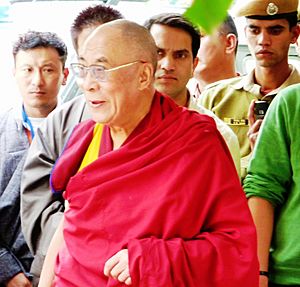
The 14th Dalai Lama, Tenzin Gyatso, was born on July 6, 1935. He was born on a straw mat in a cowshed to a farmer's family in a remote part of Tibet. He was one of 16 children. He was formally enthroned on November 17, 1950, during a battle with China.
In 1951, the Dalai Lama and the Tibetan government were pressured to accept an agreement with China. This agreement made Tibet part of the People's Republic of China. In 1959, after a revolt in Tibet, the 14th Dalai Lama fled to India. He has lived there in exile ever since, leading a government in exile.
The 14th Dalai Lama is one of the most popular world leaders. He first wanted complete independence for Tibet. But by the late 1980s, he started seeking more freedom and self-rule within China. He has said that Tibet wants to be part of China, but China should let Tibet keep its unique culture and language.
In 2019, the Dalai Lama said that after his death, he would likely be reborn in India. He also warned that any Chinese interference in choosing his successor should not be considered valid. In 2020, he stated he did not support Tibetan independence. He hoped to visit China as a Nobel Prize winner. He believes Tibetans and other ethnic groups can live in harmony within a "republic" in China.
Where the Dalai Lamas Live
The 1st Dalai Lama lived at Tashi Lhunpo Monastery. The 2nd to 5th Dalai Lamas mainly lived at Drepung Monastery near Lhasa. In 1645, after Tibet was unified, the Fifth Dalai Lama decided to build a new palace. He chose a site on Marpori ('Red Mountain') in Lhasa. This is where the Potala Palace was built.
Since then, the Dalai Lamas have spent their winters at the Potala Palace. Their summers are spent at the Norbulingka palace and park. Both palaces are in Lhasa.
After the 1959 Tibetan uprising, the 14th Dalai Lama found safety in India. He has lived in exile in McLeod Ganj, India, ever since. His home there is called the Dalai Lama Temple. Many Tibetan refugees have built schools and temples in this area.
How a New Dalai Lama is Found
When a Dalai Lama passes away, a search begins for his new form, or "reincarnation." This process involves consulting the Nechung Oracle, a special spiritual guide. High Lamas might also have visions in dreams. If the Dalai Lama was cremated, they might watch the direction of the smoke for clues.
If only one boy is found, important Lamas and officials confirm their findings. They then report to the government. A group then brings the boy and his family to Lhasa. The boy usually goes to Drepung Monastery to study and prepare for his role as spiritual leader.
If several possible children are found, their names might be placed in a special urn. A lot is then drawn in public to choose the new Dalai Lama.
The government of China has said it wants to approve the naming of high reincarnations in Tibet, including the next Dalai Lama. However, the 14th Dalai Lama has said that he would not be reborn in a country that is not free. He has also suggested that Tibetans might vote to decide if the institution of the Dalai Lama should continue. He has even supported the idea that his next incarnation could be a woman.
List of Dalai Lamas
There have been 14 recognized Dalai Lamas:
| Name | Picture | Lifespan | Recognized | Enthronement | |
|---|---|---|---|---|---|
| 1 | Gendun Drup |  |
1391–1474 | – | N/A |
| 2 | Gendun Gyatso |  |
1475–1542 | 1483 | 1487 |
| 3 | Sonam Gyatso |  |
1543–1588 | 1546 | 1578 |
| 4 | Yonten Gyatso |  |
1589–1617 | 1601 | 1603 |
| 5 | Ngawang Lobsang Gyatso |  |
1617–1682 | 1618 | 1622 |
| 6 | Tsangyang Gyatso |  |
1683–1706 | 1688 | 1697 |
| 7 | Kelzang Gyatso |  |
1707–1757 | 1712 | 1720 |
| 8 | Jamphel Gyatso |  |
1758–1804 | 1760 | 1762 |
| 9 | Lungtok Gyatso |  |
1805–1815 | 1807 | 1808 |
| 10 | Tsultrim Gyatso | 1816–1837 | 1822 | 1822 | |
| 11 | Khendrup Gyatso |  |
1838–1856 | 1841 | 1842 |
| 12 | Trinley Gyatso |  |
1857–1875 | 1858 | 1860 |
| 13 | Thubten Gyatso |  |
1876–1933 | 1878 | 1879 |
| 14 | Tenzin Gyatso |  |
born 1935 | 1939 | 1940 (currently in exile) |
There was also one leader, Ngawang Yeshe Gyatso, who was declared the "true" 6th Dalai Lama in 1707. However, most Tibetans never accepted him.
The Future of the Dalai Lama's Role
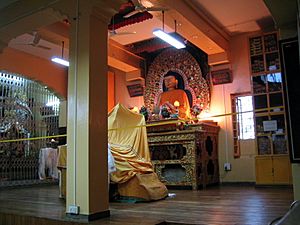
The 14th Dalai Lama has sometimes said he might be the last Dalai Lama. He believes the role might not be needed in the future. However, many Tibetans believe it is up to the Tibetan people to decide if the Dalai Lama should continue.
The Chinese government claims the right to approve high Buddhist leaders in Tibet. This includes choosing the next Dalai Lama. In 1995, the Dalai Lama chose the 11th Panchen Lama. But the Chinese government chose a different person. This led to two rival Panchen Lamas. The one chosen by the Dalai Lama has not been seen in public since 1995.
In 2007, the Chinese government said all high monks must be approved by the government. This would include the next Dalai Lama. The 14th Dalai Lama has suggested that Tibetans might vote on the future of the Dalai Lama. He has also said he would not be reborn in a country that is not free. This could mean the next Dalai Lama might come from Tibetan areas outside of China.
The 14th Dalai Lama has also said that his next incarnation could be a woman. He is open to change. He is seen as a respected moral voice around the world.
See also
 In Spanish: Dalái lama para niños
In Spanish: Dalái lama para niños
- CIA Tibetan program
- Index of Buddhism-related articles
- Tibetan Buddhism
- Gelug
- List of Dalai Lamas
- Panchen Lama
- Gelug
- History of Tibet
- List of rulers of Tibet
- 14th Dalai Lama
- Engaged Spirituality
- Patron and priest relationship


